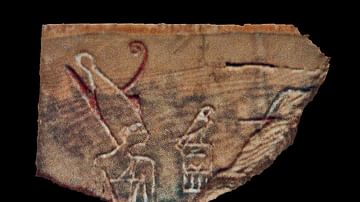Review

| Rating: | |
|---|---|
| Title: | Egyptian Art |
| Author: | Bill Manley |
| Audience: | University |
| Difficulty: | Medium |
| Publisher: | Thames and Hudson |
| Published: | 2018 |
| Pages: | 320 |
The art and architecture of ancient Egypt continue to capture the imagination of the modern world. Manley's Egyptian Art is recommended to anyone interested or with a background in ancient Egypt, architecture, cultural studies, and art history. An exquisite and utilitarian reference, this book is additionally suited for university courses in Egyptology.
Ancient Egyptian art is as recognizable as that of ancient Egypt's most enduring monuments, the Pyramids of Giza. Elegant forms clothed in bright colors, pleasant scenes of the populace active in industry or enjoying leisure, and symbols that command both temporal and spiritual authority characterize an ancient artistic tradition which lasted for thousands of years and continues to inspire us today. Egyptian Art by Bill Manley, an Egyptologist who teaches Egyptology and Coptic at the University of Glasgow and is Co-Director of Egiptología Complutense, is the newest volume in Thames & Hudson's engrossing World of Art series. At 320 pages, Manley's newest title provides a fine, in-depth introduction to the topic of ancient Egyptian art.
When surveying ancient Egyptian art, Manley concentrates on those elements of artistic expression and composition which remained constant in ancient Egyptian civilization from c. 3000 BCE to 350 CE, as well as how “archetypes” delineated contemporaneous views of power, beauty, and divinity. Divided into three parts - “Art and Creation,” “Art and the Artists,” and “Art in Context” - Manley's 14 chapters cover vast territory, however, Egyptian Art functions foremost as a survey. The tone, though academic, is succinct. The majority of the examples he utilizes in his title are drawn from a “handful of contexts,” especially tombs, palaces, and temples. One particularly nice touch that Manley adds to his series of analyses is the incorporation of text solely devoted to several celebrated masterpieces, from the gold mask and throne of Tutankhamun to the Narmer Palette and the painting of “Nebamun with his wife.”
Manley's expertise shines brightest in his overview on the role of the artisan in ancient Egypt and his relationship with his creation (Chapter 4), in addition to the stunning works of art found in and around the city of Thebes (Chapter 11). Special note should be made of Manley's examinations of the art from the Amarna Period and the periods when Egypt was under Persian, Greek, and Roman domination (Chapters 12 and 15, respectively). If there's any meaningful critique of Egyptian Art, it is that it is most surprising that a chapter was not added concerning the enduring influence of ancient Egyptian art in the Levant or Greece. Manley briefly mentions the influence Egyptian art played in Kush and Meroë, but there's little else offered, aside from an image of the Minoan frescoes from Tell el-Daba. Along with an index, there is a fine map of ancient Egypt, a chronology, and list of pharaohs, a notes section, and a selected bibliographical listing of titles for further reading. With 274 illustrations, most of which are in color, Egyptian Art is a lavishly illustrated book. This fact alone will likely appeal to many readers.
About the Reviewer
Cite This Work
APA Style
Wiener, J. B. (2017, December 05). Egyptian Art. World History Encyclopedia. Retrieved from https://www.worldhistory.org/review/182/egyptian-art/
Chicago Style
Wiener, James Blake. "Egyptian Art." World History Encyclopedia. Last modified December 05, 2017. https://www.worldhistory.org/review/182/egyptian-art/.
MLA Style
Wiener, James Blake. "Egyptian Art." World History Encyclopedia. World History Encyclopedia, 05 Dec 2017. Web. 09 Apr 2025.




